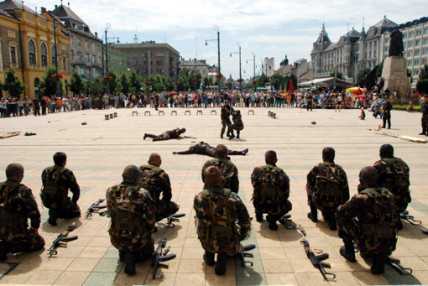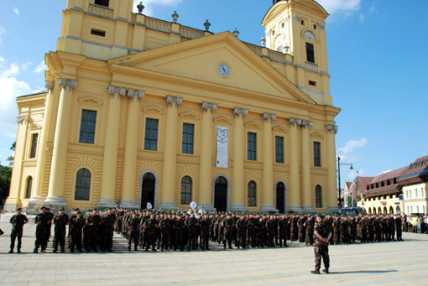Kossuth Square Was Swarming With Soldiers
Szöveg: László Szűcs | 2008. július 15. 6:50The citizens of Debrecen have never seen anything like this before: soldiers breaking tiles and roof-slats on each other, in front of the main church. Meanwhile, from the loudspeaker mounted on the jeep nearby rock music rattles. Next to the tram tracks a checkpoint is operated by the soldiers in uniform and with painted faces. And we haven’t mentioned the valediction of the battalion going on mission, and the opening of the festival of the military bands. Honvedelem.hu reports from the site.
At eleven a.m. the thermometer in Debrecen’s main square already shows 26 C°, the heat almost flickers above the flagstones. Of course, being end of June, it is not surprising; what’s surprising in turn are the two huge BTR combat vehicles blocking one of the streets leading to the square. Further stands a giant eight-wheeled Man truck. On its top are three kids, half a dozen another are reading the information board. It turns out that this iron monstrosity is practically a tow truck.
Furthermore, there is also a jet-black inflatable boat and a “box-shaped" military ambulance to be seen. Both of them are surrounded by curious youngsters, showering the soldiers standing besides the vehicles with questions. No question remains unanswered.
There is already a huge crowd, even though officially working hours are not over yet. At the tents, set up on both sides of the road, more than hundred people are watching the uniforms and weapons used by the soldiers. The braver take the machine guns into their hands, or peep into the telescopes of the sniper rifles. But the real hits are the night vision goggles; many don’t understand why these cannot be used during daytime. The soldiers explain patiently.
– Imagine what happened! Kossuth Square and Piac Street leading there is taken over by soldiers – tells a stupefied passer-by on his mobile phone to someone, while walking by a khaki tent. Inside face-painting is going on, painting green and brown and black those brave enough. It is an interesting sight as the muscled surveillance soldier paints the face of a three-year-old girl’s face with gentle moves.
Naturally it is no accident that the soldiers of Debrecen occupied Kossuth Square on this day, namely 27th June, for this is the day of Saint Ladislaus, the patron saint of riflemen. And the city of Debrecen is the “home" of ‘István Bocskai’ Infantry Brigade.
The bold idea was conceived a few months before, at the headquarters of the brigade. The commanders decided to organize this year’s day of infantrymen in the city center, not at the barracks, as opposed to traditions.
The idea worked, since — despite being 11 o’clock on a Friday — several hundred people are watching the hand-to-hand combat show in front of the Great Church. The soldiers of the brigade’s ‘Gergely Bornemissza’ Surveillance Battalion not only show the armed drills, but also how to neutralize a person attacking with knife or pistol. Then the highlight of the program follows: roof-slats and tiles are broken on the backs, chests, heads, arms and shinbones of soldiers.
– They use so much material with which a small house could be roofed – observes an onlooker comically.
Meanwhile, the temporary checkpoint set up a few meters away is under attack. The soldiers have to stop the angry crowd by force. This show is also great success; there are so many onlookers that the tram no 1, traveling through the square, can pass the by-standers only with great difficulties and at a snail’s pace.
– Don’t be afraid honey, they won’t hurt them, they just show us what they would do to bad guys – says a grandma in the crowd to her grandchild, who watches scared as the soldiers handcuff one of the “bad guys".
Of course those who want a less fierce show also are on to a good thing at the main square. The employees of Hajdú-Bihar County’s Recruitment Office operate an aircraft simulator in one of the tents. In the tent of the tradition’s keepers and maquette-makers the curious get to know the weapons and the proportionally reduced technical devices used by the Hungarian Defence Forces in World War II.

With this many programs one doesn’t notice the progress of time. It is already 4.30 p.m., the participants of the 16th International Festival of Military Orchestras start to march into the square. The eight teams marche through the city in dress uniform, playing marching songs. The opening of the three-day festival and a joint concert will take place today in front of the Great Church. But first the soldiers of the Hungarian KFOR battalion, going to Pec in Kosovo, line up in the shadow of the Lutheran church. In the middle of the summer more than four hundred Hungarian troops begin their half-year service in the Balkans. During the last three month they have been preparing for the tasks waiting for them at the operational area, and now, according to military traditions, their commanders bid farewell to them.
– The KFOR-battalion, established at the headquarters of the first battalion of István Bocskai Infantry Brigade accomplished the tasks of preparation. It is ready, with its staff and technical equipment for redeployment, and to execute the task at the operational area – reports Lieutenant Colonel László Mórucz, commander of the contingent. Lieutenant General (Eng.) László Tömböl, commander of the Joint Forces Command of the Hungarian Defence Forces acknowledges the above, then stepping up to the microphone, he says farewell to the soldiers.
– Even now almost one thousand Hungarian soldiers participate in seventeen missions in thirteen countries of three continents to manage different crises and conflicts – says the three-star general, than he speaks about how the contingent setting off to foreign service is a good example that in the 21st century only professionally prepared soldiers can meet the new challenges.

— Thanks to their preparedness and competence Hungarian soldiers earned great fame for themselves. Where you will go now Hungarians are well-known, since for years our fellow countrymen have been serving there – emphasizes the commander.
Mr Zoltán Pajna, deputy mayor of the city asks the soldiers setting off abroad to come back safe and sound, so that we could welcome them in six months at the same place, here in front of the Great Church.
After the parade march of the peacekeeping forces the square is taken over by the participants of the military orchestras’ festival. The central orchestra of the Hungarian Defence Forces, the garrison bands of Debrecen, Székesfehérvár, and Szentendre are lining up one after the other. There are foreign participants, also: from Greece the military band of Athens, from Romania the band of the 4th corps, from Austria the band of Carinthia, from Turkey the tradition-keeping military band have come to Debrecen. Of the last it is good to know, that they are the longest-standing military band in the world, established in 1289. According to one onlooker they seem as if they have just arrived from the siege of the fort of Eger.
— The bands lined up here are part of tradition and professionalism, old and new, trade and culture at the same time – says in his opening speech Dr. Péter Szeredi, MoD Head of Cabinet. He emphasizes: this festival is for those who have never seen military orchestras before.
— Members of these bands are disciplined soldiers, who wear the uniform and play their instruments with the same dignity as their forefathers many hundred years before – with these words the Head of Cabinet officially opens the three-day international event.
The first program of the bands is a joint concert, where – besides the unomitable marching songs – evergreen hits are also played. The audience likes the music, which practically won’t fall silent until Sunday evening, at which time the festival would end.